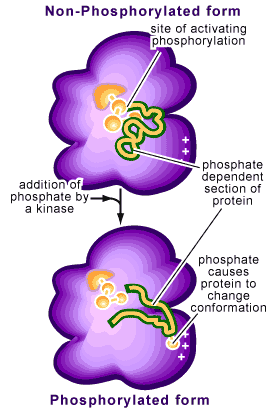Daily Newsletter February 9, 2012
Administrative Notes:
Due to a technical error, CPR has not opened the assignment. It will be opened later today. An announcement will be sent out when it is open. Until then, if your paper is ready, make sure you take some time to review and edit before uploading.
Today's Topic: Protein Kinases
Kinase refers to a group of enzymes that transfers a phosphate group from one molecule to another. The term applied to this process is Phosphorylation. Notice that the word kinase ends with the suffix -ase. This suffix is used to denote an enzyme, and you will see nearly every enzyme ending with the suffix -ase (remember this). Protein Kinases refer to a subgroup of kinases that phosphorylate proteins.
Kinases are generally named for the substrate that they phosphorylate. So, myosin heavy chain kinase will phosphorylate the heavy myosin chain. Cdk-activating kinase will phosphorylate another enzyme known as CDK (CDK is important in regulating cell division, and we will come back to this enzyme in a few weeks).
Remember that enzymes are proteins folded into at least a tertiary structure, and that protein structure is determined by electrochemistry of the individual amino acids. A phosphate carries a -2 charge. When you bond a phosphate group to an enzyme, you alter the charges of the molecule, and thus alter the shape of the molecule. This shape alteration is generally referred to as either a confrontational shift or conformational shift (the latter term is more common). This shape alteration will result in either the activation or deactivation of the protein/enzyme. The following cartoon will give you a good visual of the effects of phosphorylation.
Daily Challenge:
In your own words, describe how the action of a protein kinase can alter the function of a protein. Use the Insulin Signal Transduction pathway as your means of discussing kinase activity.

No comments:
Post a Comment